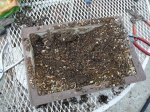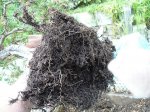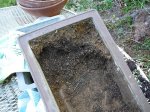Mike Corazzi
Masterpiece
As you probaly know, I am a NON fan of akadama due to some catastrophic degradation of NEW aka.
Which has put me in the ALL lava camp.
But the more I talk to people in the club, the father apart the opinions get.
A ...lot... of very successful bonsaists use a MIX.
Now I mixed ...some... stuff with both the lava and the aka.
Not much and the BIGGEST part of the soil was aka on my near disaster (pic of concreted aka included)
and it went BAD. Water wouldn't even soak in let alone drain out and the soil was WET for days after a watering.
Now THAT does not happen with my lava.
But that doesn't explain the success of those who use aka either wholly or in PART (as in MIXED0
So..... long story short, what IS the advantage of aka? Does it hold more moisture longer (barring the uncertainty of degradation) or hold fertilizer better and a bit longer? I know the lava drains FAST.
Yet it has appreciable MOISTURE.... not soggy water... for quite a long time. Even on hot days.
Akadama fans, pls elaborate
Lava please do also.
Thanks.




Which has put me in the ALL lava camp.
But the more I talk to people in the club, the father apart the opinions get.
A ...lot... of very successful bonsaists use a MIX.
Now I mixed ...some... stuff with both the lava and the aka.
Not much and the BIGGEST part of the soil was aka on my near disaster (pic of concreted aka included)
and it went BAD. Water wouldn't even soak in let alone drain out and the soil was WET for days after a watering.
Now THAT does not happen with my lava.
But that doesn't explain the success of those who use aka either wholly or in PART (as in MIXED0
So..... long story short, what IS the advantage of aka? Does it hold more moisture longer (barring the uncertainty of degradation) or hold fertilizer better and a bit longer? I know the lava drains FAST.
Yet it has appreciable MOISTURE.... not soggy water... for quite a long time. Even on hot days.
Akadama fans, pls elaborate
Lava please do also.
Thanks.



